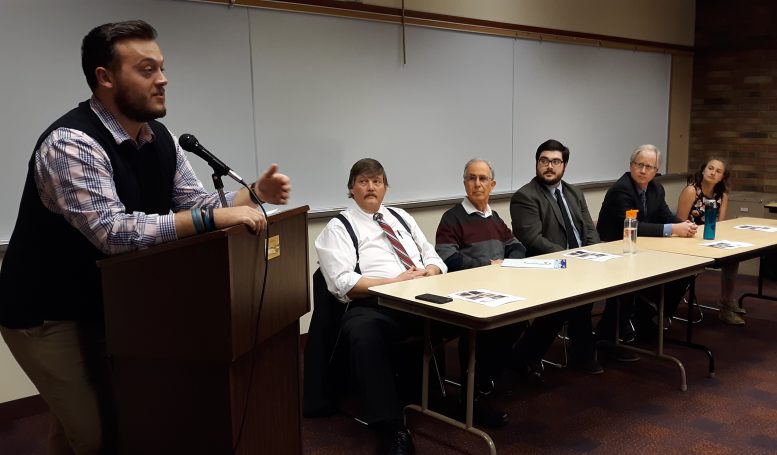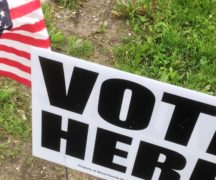By JAN LARSON McLAUGHLIN
BG Independent News
Bowling Green voters got to hear from five City Council candidates whose names appear on the primary election ballots on Tuesday.
Only two City Council races have primaries this spring – and both are between Democratic candidates.
Running for the at-large council seat are incumbent Bruce Jeffers and challenger Neocles Leontis.
And running for the First Ward council seat are incumbent Mark Hollenbaugh and challengers Connor Goodpaster and Madison Stump.
All five candidates fielded questions posed recently during a forum held by the Wood County Young Democrats and BGSU College Democrats.
Following are the questions and the candidate responses.
How will the candidate work to improve economic development?
Goodpaster, a BGSU graduate and government professor at Wayne State University, said the city should work on updating its zoning, housing, and focusing on the type of jobs that would best benefit the city.
“We need to be pursuing more knowledge-based occupations,” he said.
Goodpaster also said that since the state privatized much of its economic development efforts, it leaves local governments in the dark.
“I know what bait we have,” to attract businesses, he said. But communities are “fishing in murky waters.”
Zoning updates are needed to allow for more combined property uses, and affordable housing is needed for young residents.
Hollenbaugh, a history and government teacher at North Baltimore High School, noted Bowling Green’s “awkward” location between Toledo and Findlay. Bowling Green has worked to establish business and industrial parks to attract companies.
“Sadly, the result has been a lot of low-level manufacturing jobs,” with wages too low to pay for housing in Bowling Green, he said. “We need to attract jobs that aren’t low-level manufacturing jobs.”
The city needs to promote its greatest assets – its reliable and inexpensive public utilities, its access to major transportation routes, and its relationship with BGSU, Hollenbaugh said.
“There are a lot of new innovative ways to be an incubator with the city and BGSU,” he said.
Jeffers, a math teacher at Otsego High School, pointed out the city’s “painstaking” planning efforts to help attract economic development.
The city has worked with consultants to update its land use plan, create a Community Action Plan, and form a strategy for East Wooster Street. Those plans were the product of a great deal of citizen input and community meetings, he said.
“We’ve set the stage” for bringing in business, Jeffers said.
The bigger issue right now appears to be finding employees to fill local job openings. Jeffers has worked to build the Welcome BG Initiative into a program that connects immigrants with jobs.
The city also needs to work on revitalizing older neighborhoods, he said.
“We need to have the kind of housing and amenities that will attract employees,” Jeffers said.
Leontis, a chemistry professor at BGSU, said city leaders should set their sights at higher levels – and hold the state responsible for defunding local government and state institutions like BGSU.
State officials need to “stop austerity funding,” he said.
More emphasis should be placed on helping ordinary people living on limited incomes, Leontis said.
“Those people create jobs by creating demand,” he said. “We need more emphasis on the bottom up.”
Economic development will occur if government works on “making lives easier for working people,” Leontis said.
Stump, an environmental policy student at BGSU, said true economic development means not only bringing in the jobs – but also making sure they have options to make their homes here as well.
“It’s attracting young professionals and making sure they have jobs here,” and homes here rather than living in Perrysburg or Findlay.
Stump said the city should focus on bringing in investors for the East Wooster corridor businesses and housing. She also said the new entrance to the city at Interstate 75, with the roundabouts on East Wooster Street, may help.
Right now, visitors “aren’t impressed with what they see,” if they don’t make it as far as the downtown area, she said.
What is the role of the city in improving relationships between long-term residents and the university?
Stump suggested ways to strengthen relationships by creating more events that involve long-term residents and BGSU students. She talked about the possibility of more downtown events and community trash cleanups.
“Community improvement really needs everyone together,” she said.
City Council must listen to constituents, Stump said. “Council really has an important job in empowering those constituents to share.”
“We need a local government who will listen to us,” she said about BGSU students.
Leontis said City Council has not been responsive to some residents, who have gotten discouraged. He noted the lack of movement by the city on rental housing standards, and questioned if students are not respected because “they’re not voting in large numbers.”
“Do we have to get all the students to vote before we change anything,” Leontis asked. “Is this controversial that we have safe housing in Bowling Green?”
Hollenbaugh estimated 90 percent of BGSU students are good members of the city, and take pride in the community. He noted the efforts made by the East Side neighborhood organization to work with students.
“The majority of them are excited and want to help,” he said.
But problems still exist – specifically between midnight and 3 a.m. when East Side homes are damaged or items stolen from yards and porches.
“I really think the university needs to do a better job of educating their students about what it means to be a responsible member of the community,” he said.
Hollenbaugh also endorsed the creation of more events that would build positive interaction between residents and students. If there are more “shared experiences” at events like Court Street Connects and Firefly Nights, “hopefully we’ll all get along a little better.”
Jeffers talked about efforts that have brought the community together with rallies at the Wooster Green for issues such as immigration.
“We didn’t want Bowling Green to be that kind of community,” he said, referring to national immigration policies pushed by President Donald Trump.
Jeffers also mentioned the concrete actions initiated by the Welcome BG efforts.
“So much of this takes planning so you’re not just reacting to the rhetoric,” he said.
He also talked about the recent racist attack at the Waffle House in Bowling Green, and praised the community response to that incident.
Goodpaster talked about the need for city government to work with student citizens.
“We want to help students have ownership of the town,” he said.
That may mean organizing trash pickups involving students.
“You see it every single weekend – trash,” he said. “If we can get people to take ownership of the town, and mobilize organizations to bridge the gap.”
But Goodpaster cautioned against delays while waiting for plans to be completed. Enrollment numbers at BGSU are predicted to drop if the community doesn’t make some major improvements in the next five years, he said.
“We need bold leadership,” he said.
How can Bowling Green continue to be a leader in green energy?
Goodpaster praised the city’s green energy commitment, and suggested the efforts be expanded to the state and county level so they are working with “one loud voice.”
He talked about the city’s long-term arrangement with a coal-fired plant, saying the city can’t afford to switch from that now. However, he suggested the city be ready when it is able to drop its deal.
“It’s all about setting up infrastructure now for our successes in the future,” he said. “Green jobs are the future.”
Goodpaster also said he supports a single-use plastic bag ban in the city, and bike lanes.
Hollenbaugh spoke of the need for the city to make decisions based on the costs and benefits.
Bowling Green already uses diverse sources of wind, solar and hydro electric for much of its power.
“We cannot go green tomorrow,” he said. “We need to move forward in renewable directions as they are cost effective. Ideally, in the future, it would be great.”
Jeffers said Bowling Green residents are very supportive of green energy – and the city has responded accordingly.
“We have the largest solar field in the state of Ohio. I voted for that,” he said.
City Council has had the “courage” to undertake such green energy projects, knowing that “Bowling Green residents will support this,” he said.
The city is now working on another solar site on county land, and is promoting energy conservation by supporting Columbia Gas audits of home insulation, and encouraging residents to use mulching mowers and let leaves stay on their lawns.
Leontis supports the city’s green energy efforts, and said the nation needs a comprehensive climate action plan.
“Green energy is a source of energy that eliminates greenhouse gases,” he said.
He advocated for more mass transit, more walking and biking to city destinations.
“If we make safe bikeways, maybe more people will bicycle,” he said.
Leontis said energy audits have indicated that half of the apartments in Bowling Green are inefficient and lack proper insulation. Landlords should be required to properly insulate their rental units, he said.
“We need the carrot and the stick together,” he said.
He also suggested the city get involved in composting food waste, which creates methane gas in landfills. “We’re behind in Ohio,” he said.
Stump said going green can be a “scary initial investment” for cities, but there are grant opportunities available. She suggested the city partner with BGSU, which is planning a solar project on campus.
She also suggested the city pursue more wind energy – despite possible opposition from critics who say “not in my back yard.”
“We’re in a really great spot for wind energy,” Stump said, adding that the city should pursue investors and grant funding.
How can City Council better strengthen inclusion in Bowling Green?
Stump said community events would help create “a safe and brave space to foster collaboration.”
She also recommended the city work with BGSU to use the bystander training already offered at the university. Such training was requested by the community after the recent racist attack at Waffle House.
“So we are not just pledging we are inclusive,” she said. The city needs to be clear, “this is something we don’t stand for,” she said of the attack.
Leontis said the city needs to be aware of micro-aggressions and discrimination occurring in the community.
“There are very complicated forces in our society that make it difficult for some to flourish,” he said.
He suggested that city employees may benefit from sensitivity training.
Leontis stressed that the city should respect BGSU students enough to guarantee a transparent rental market. His campaign has focused on the need for mandatory fire inspections of rental units.
“They don’t even know it’s not safe,” he said of many students and their housing. “It is shameful.”
Frequent inspections are required of restaurants and hotels – but no inspections are required for old houses converted into rental units.
“Rentals are public buildings,” Leontis said, noting that they are businesses that owners profit from.
Jeffers talked about the importance of appreciating a variety of opinions. Residents on the East Side of the city have valid concerns about their neighborhoods being turned into rental areas.
“They are rightfully concerned with neighborhoods,” he said.
But Jeffers objected to Leontis’ characterization of rental units.
“I really have a big problem with someone wanting to be on City Council saying that Bowling Green housing is unsafe,” Jeffers said. “That’s a ridiculous thing to say.”
City Council has considered the idea of mandatory inspections before, and has rejected it, he added.
The Community Action Plan does suggest a rental registration program, but the city attorney said it would be problematic, Jeffers said.
Renters with concerns can request inspections by the fire division, health department, or building inspection.
“If you feel you are in a property that might be unsafe” call, Jeffers said. “We have safe housing in Bowling Green. It’s not perfect, but we have safe housing.”
Hollenbaugh talked about efforts made by the city to be inclusive – such as changing the preamble to the City Charter and passing anti-discrimination ordinances.
“Bowling Green, despite whatever flaws it might have, has always strived to be a welcoming community,” he said. “But there’s always more we can do.”
That may include working on an educational program for business employees and others about how to handle incidents like the attack at Waffle House.
“I think a lot more can be done to educate people” to recognize the signs and stop aggression before it escalates into violence, Hollenbaugh said.
Goodpaster noted the existence of several hate groups in Northwest Ohio, but said, “Bowling Green is a good place.”
“It’s about education. We have to reach people,” he said, starting in grade school and continuing with de-escalation training for bystanders.
“It’s time for us to lead. Let’s come up with a plan,” he said.
Goodpaster also said he supports the use of a mandatory rental registry in the city.
“Our housing is not the safest housing in this area,” he said. “If you live in a rental, you know.”





